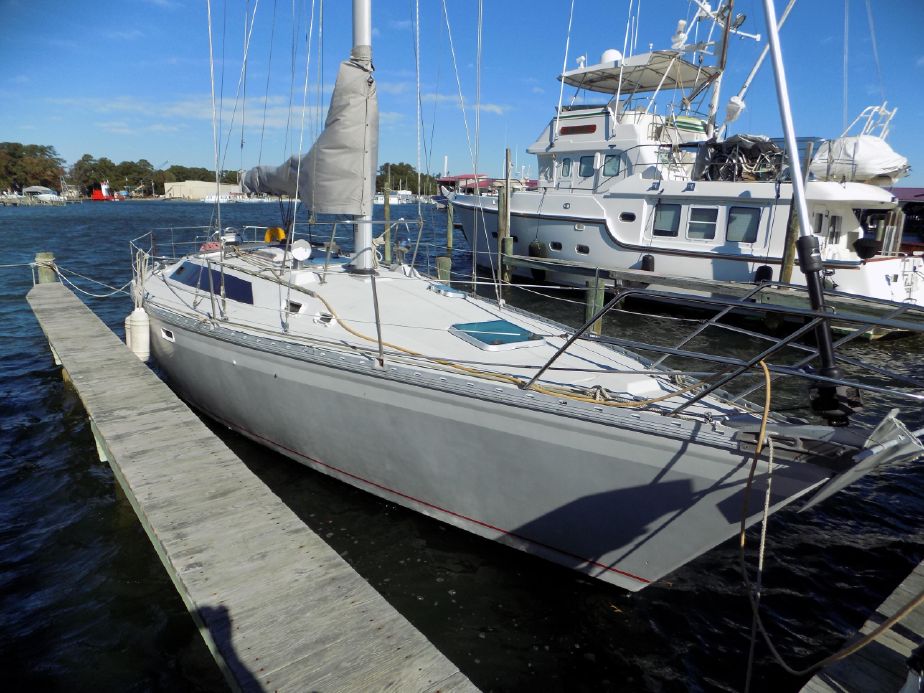Although O’Day Boats, of Fall River, MA, failed to survive a previous downturn in our economy, the company’s 30+ years building affordable daysailers and family cruisers introduced more than a few sailors of my generation to our sport. In these tough economic times, it’s perhaps fitting that we take a look at the O’Day 40—still one of the more affordable family cruisers of this size and age.
Introduced in 1985, the O’Day 40 is the largest model ever built by the company and remained in production until 1989. Although there are enough similarities to consider this a redesign of the earlier O’Day 39, there are enough differences that I’m focusing only on the O’Day 40 for this review.
Depending on the source, design credit for the O’Day 40 goes to C. Raymond Hunt Associates or Philippe Briand. My admittedly limited investigation was not able to confirm, with certainty, but I suspect both likely had a hand in the project. Hunt Associates designed nearly all previous O’Day cruising models, but the distinct European-influence of this design is certainly reminiscent of Briand’s work.
In a departure from previous construction methods, the hull of the O’Day 40 is a cored composite using three-quarters of an inch of balsa, polyester resin, and biaxial fiberglass cloth. Decks are also composite constructed with balsa and plywood core, and structural support is provided by a combination of fiberglass liners, plywood bulkheads, and various longitudinal and athwartship supports. Generally, the quality of construction, fit, and finish is typical of entry-level boats of the 1980s. Attachment of structural components seems to have been done well, and it’s rare to find any serious concerns in these areas.
Unless remedial repairs have been made, O’Day 40s are likely to have some degree of osmotic blistering below the waterline. And, because osmotic blisters and water permeation can be more problematic on balsa cored composites, it is best to get a knowledgeable professional’s evaluation if blisters are present or suspected. Cracking and crazing of the fiberglass decks are also quite common and sometimes severe enough to affect the structural integrity; so any questionable areas should also be evaluated by a professional.
The O’Day 40 has a nicely designed deck featuring a low cabin trunk which gradually slopes to the foredeck. Cabin sides are angled to wide side decks providing a secure footing as the boat heels. There is a large anchor locker on the foredeck and a perforated, extruded aluminum toe rail. The cast aluminum lifeline stanchions are at the rail, so lifelines do not intrude on deck space. Cockpit seating is comfortable with a deep seat locker to port and a shallow locker to starboard. There is a gate in the stern rail for access to a small “sugar scoop” transom swim deck with a folding boarding ladder that can be reached by someone in the water. This is a safety feature now recommended by ABYC standards, and O’Day was ahead of their time.
The interior arrangement is fairly standard with a V-berth cabin forward followed by a port head/shower and a starboard hanging locker. The main saloon has a U-shaped dinette with a drop-leaf table to port and a settee to starboard. There is a spacious galley aft to port with a forward facing navigation station opposite. The quarter berth cabin has a large athwartship, double berth tucked under the cockpit. While there is plenty of head room, hip room is tight, and whoever sleeps aft must crawl over the head of his bunk mate in order to exit first.
Not such a good idea is the extra head crammed into the quarter berth cabin which offers no privacy for users. The space would be much better utilized for storage.
Auxiliary power is provided by a Westerbeke 46-horsepower marine diesel engine which is more than adequate for a boat whose design displacement is less than 20,000 pounds. The engine is located below the companionway steps, and reasonable access is provided by removing the steps and access panels along the starboard side and aft.
The O’Day 40 has a rather conservative sail area/displacement ratio of only 16.3, but is also on the light side, for a mid-1980s cruiser, with a displacement/length ratio of 214. One measure of performance, U.S. Sailing’s PHRF (Performance Handicap Racing Fleet) rating shows an average handicap of 114 for the O’Day 40. For comparison to other boats of the same era, her rating is 39 seconds per mile slower than the popular J/40 racer/cruiser and 57 seconds per mile slower than the “strictly cruising” Island Packet 38.
Affordability is what attracted buyers to the O’Day 40 when she was new, and it remains an attraction more than 20 years later. Presently, there are seven O’Day 40s listed for sale at the yachtworld.com website with asking prices ranging from $59,000 to $89,000. The average selling price over the last year has been $55,000. For price comparison only, selling prices of similar age J/40s and Island Packet 38s have averaged $120,000 and $108,000, respectively.
I don’t mean to compare the quality of these models, but despite some flaws common to most aging, entry-level sailboats, the O’Day 40 remains a lot of boat for the money and could be an excellent value, particularly for sailors capable and willing to invest some of their own “sweat equity” in needed maintenance and repairs.
Specifications:
LOA 39’ 7”
LWL 33’ 6”
Beam 12’ 7”
Displacement 18,500 lbs
Draft 4’ 11” Shoal
6’ 4” Deep





